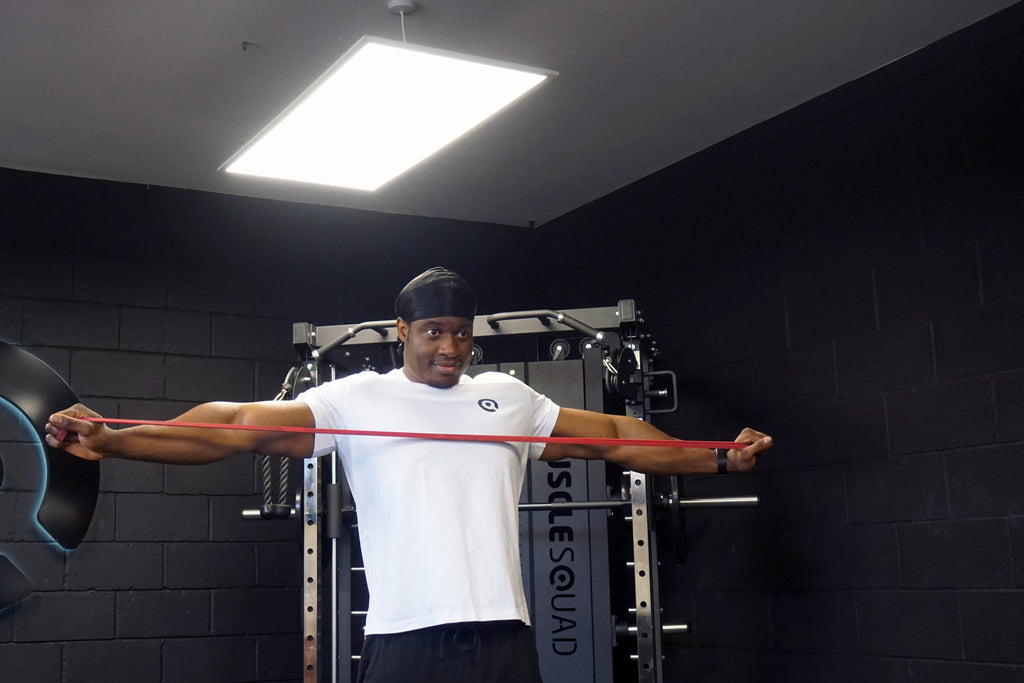Warming up is, and should be fundamental part of any, and everybody’s training, regardless of what exercises you will be performing, or even what level you are at. If we are honest, most people skip and neglect warmups because they are not deemed as “fun” or seemingly “important” as the main workout. Warming up has many benefits, from a physiological and a psychological perspective. Starting with physiological, one of the main benefits to warming up is injury prevention. By warming up you are effectively increasing the blood flow to your muscles, which lowers the chance of a muscle pull or joint injury. From a mental perspective warming up as a great way to prepare your mind as well as your body for the task ahead. It gets you into the zone and ready to take on the workout whatever it may be.

Muscle Building
In the pursuit of hypertrophy (muscle building), the best “warm up” exercise is the often the one you are about to perform. For example, if you are about to do a dumbbell chest press, an effective method to warm up the chest would be to perform lightweight dumbbell chest presses at a low intensity. This will prime your nervous system and get blood into your chest, shoulders, triceps etc to put you in a state ready to perform the movement pattern under heavy load.
Resistance Bands
Another way that some people warm up is to use resistance bands or cables to warm up the joints or muscle they are going to work, as well as the antagonist muscle (opposing muscle) and the surrounding or stabilising muscles. A couple of examples of this would be for a powerlifter performing a bench press, they want to warm up the opposing muscles of the chest, which is the back, so they can remain “tight” and contracted under heavy loads. Warming up the triceps which are secondary muscles used in the bench press can also be beneficial. Then an example of warming up with bands could be “glute activation” for training the glutes. Doing banded movements for the glutes allows you to really focus on contracting the muscle and feeling it work, giving you that mind to muscle connection before you start to train with heavier weight.

Cardio Warmups
For cardio based warmups, the benefits are things like improved circulation, improved fitness and endurance, and reduced risk of injury, although if you do too much, it might tire you out before you have even begun your workout proper.
It is not just about getting on the bike, cross-trainer, or rowing machine, though, your specific cardio warm-up should depend on the workout. If you are doing LISS (Low Intensity Steady State) cardio, then do a warmup to reflect that, things like walking, butt kicks, simple jumping jacks. If you are preparing for a HIIT (High Intensity Interval Training) session, multi-joint movements like sprinting on the spot, getting arms and legs involved, jump squats and bodyweight squats would work well.
Foam Rolling
Another growingly popular warm up method is foam rolling. Some people also like to use massage guns too. These act as a way of doing self-myofascial release, by relieving any muscle tension which can be useful if you’re sat at a desk all day. Some people opt to do these before a session, others opt to do it after as a form of recovery to promote blood flow.
Stretching
Dependant on the exercises you are going to perform, some people like to add stretching into their warmup routine. There are 2 types of stretches: static and dynamic.

Dynamic Stretching
This a form of movement-based stretching, examples include things like butt kicks, knee tucks, and arm circles, all involve movement that you can work your way into, slowly increasing the range of motion a bit.
Dynamic stretches are great for getting your heart rate up, and are particularly useful in sports like football, running or functional training, however they are a little trickier than static stretches though. Dynamic stretching exercises require more coordination and control than static stretching, which may be challenging for some people.

Static Stretching
This involves stretching a muscle to near its furthest point and then holding that position for at least 15 or 20 seconds. The emphasis is often to focus on a single muscle group with each stretch. The benefits can include improved flexibility, and reduced muscle soreness when performed after a warmup or cool down.
One thing to keep in mind is that stretching is most effective once the muscles have warmed up, stretching as a warm-up activity may temporarily decrease muscle strength, muscle power, and exercise performance.
We hope this helped provide insight on the benefits of warming up and now why not dedicate 5-10 mins at the start of your workout to warming up, to help prevent injury and soreness. Assess your workout style and goals and see what kind of warm up you will need for the session ahead.

 Apr 13, 2023 - Think Shaw
Apr 13, 2023 - Think Shaw
1 comment
May 30, 2023 • Posted by Malick
Well stated that “Warming up is, and should be fundamental part of any, and everybody’s training, regardless of what exercises you will be performing, or even what level you are at. If we are honest, most people skip and neglect warmups because they are not deemed as “fun” or seemingly “important” as the main workout. Warming up has many benefits, from a physiological and a psychological perspective.” Interested people can search here for fitness-related equipment.
https://www.maskura.co.uk/collections/fitness
Leave a comment: